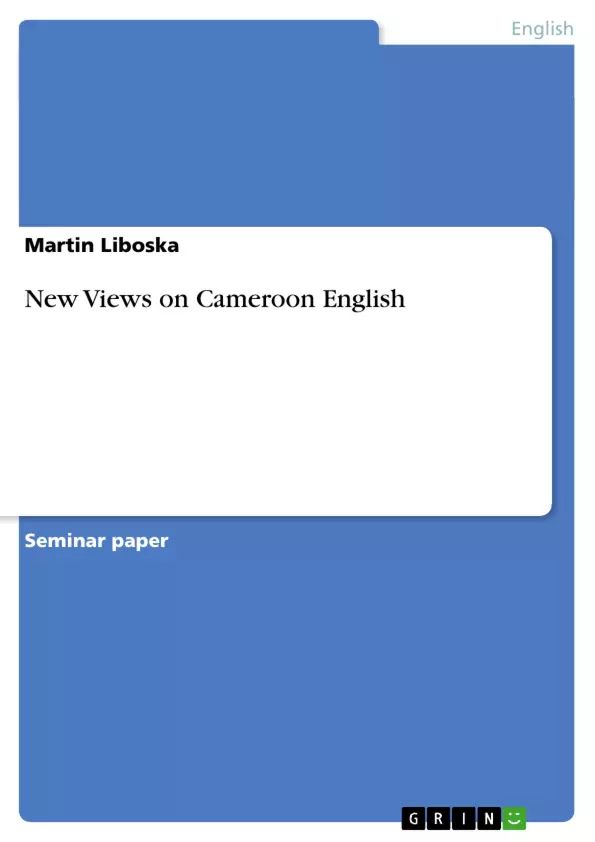English in West Africa is a complex field of investigation in the broader context of the “World Englishes”. For many years, researchers have focused on linguistic characteristics of the numerous varieties of English in this area and mostly subsumed them under the label “English in Africa” or “West African English” (WAE) (e.g., Spencer 1971; Todd 1984b; Kachru 1995, Schmied 1991). Only little attention has been paid to the single national varieties1 including Cameroon English (henceforth CamE), which is in fact a very interesting case for sociolinguistic analysis due to its status as a co-official language beside French in a multilingual environment. This paper aims to show that new approaches to the national West African varieties, in this case CamE, try to fill the gap of comparative research in this linguistic area. The first part of this paper shall introduce the reader to the complexity of the linguistic situation in West Africa in general. The status, function, and use of English in the anglophone West African countries will be determined in chapter 2. Then I will give an overview about the development of the two most important varieties of English spoken there, namely Pidgin English (PE) and WAE. This chapter will therefore serve as a basis of knowledge for the third chapter, which is the main part of this paper and deals with the new approach of Hans-Georg Wolf (2001) to “English in Cameroon”. By showing the results of the author’s study about the extraordinary sociolinguistic situation in Cameroon on the one hand and the lexical peculiarities of CamE on the other hand, I will support his main thesis, which classifies CamE as a distinct national variety within the linguistic region of West Africa. Finally, I will draw a conclusion and give proposals for further studies in this field of investigation.
Inhaltsverzeichnis (Table of Contents)
- 1. INTRODUCTION.
- 2. THE STATE OF KNOWLEDGE ABOUT “ENGLISH IN WEST AFRICA” BEFORE THE YEAR 2000.
- 2.1 THE COMPLEX LINGUISTIC SITUATION IN WEST AFRICA.
- 2.1.1 The status of English in West Africa.
- 2.1.2 The function and use of English in West Africa.
- 2.2 THE VARIETIES OF ENGLISH IN WEST AFRICA.
- 2.2.1 West African Pidgin and Creole English.
- 2.2.2 Standard West African English (WAE).
- 3. NEW VIEWS ON CAMEROON ENGLISH: DISTINCT NATIONAL VARIETY OF ENGLISH?
- 3.1. THE SOCIOLINGUISTIC SITUATION IN CAMEROON AND THE ANGLOPHONE SPEECH COMMUNITY.
- 3.1.1 The de facto status of English in Cameroon.
- 3.1.2 The Anglophone speech community.
- 3.1.3 Cameroon English: a symbol of Anglophone “identity”.
- 3.2 LEXICAL PECULIARITIES OF CAME.
- 3.2.1 Frenchification of the lexicon of CamE.
- 3.2.2 Nativization of Cameroon English.
- 3.2.3 Contextualization.
- 4. CONCLUSION.
Zielsetzung und Themenschwerpunkte (Objectives and Key Themes)
This paper aims to explore the complexities of Cameroon English (CamE) as a distinct national variety within the broader context of English in West Africa. It seeks to demonstrate that CamE, while influenced by both French and indigenous languages, exhibits unique characteristics that distinguish it from other West African English varieties.
- The sociolinguistic landscape of West Africa and the status of English in the region.
- The development and evolution of West African Pidgin English (PE) and Standard West African English (WAE).
- The specific sociolinguistic context of Cameroon, including its bilingual nature and the role of English within the Anglophone community.
- The lexical features of CamE, including the influence of French and the process of nativization.
- The argument for recognizing CamE as a distinct national variety of English.
Zusammenfassung der Kapitel (Chapter Summaries)
Chapter 1 introduces the subject of English in West Africa, highlighting its complex linguistic situation and the growing interest in studying national varieties like CamE. Chapter 2 delves into the historical background of English in West Africa, outlining the status and functions of English in the region, as well as the development of key varieties like West African Pidgin English and Standard West African English.
Chapter 3 focuses on CamE, analyzing the sociolinguistic situation in Cameroon, including the status of English within the Anglophone community, and exploring the lexical characteristics of CamE. This chapter examines the influence of French and the processes of nativization and contextualization that shape the vocabulary of CamE.
Schlüsselwörter (Keywords)
The main keywords and focus topics of this paper include Cameroon English, West African English, English in West Africa, language policy, bilingualism, sociolinguistics, pidgin, creole, lexical variation, Frenchification, nativization, and national variety.
- Citation du texte
- Martin Liboska (Auteur), 2004, New Views on Cameroon English, Munich, GRIN Verlag, https://www.grin.com/document/29650



